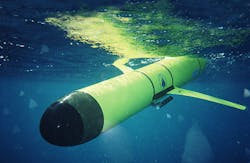Teledyne Brown to build and upgrade undersea glider UUVs to gather data for anti-submarine warfare (ASW)
SAN DIEGO – U.S. Navy anti-submarine warfare (ASW) experts needed unmanned underwater vehicles (UUVs) that gather data to help Navy surface ships, submarines, and aircraft find and attack enemy submarines.
Officials of the Naval Information Warfare Systems Command in San Diego announced a $27.4 million five-year contract on 30 June 2021 to Teledyne Brown Engineering Inc. in Huntsville, Ala. to build and upgrade UUVs for the Navy's Littoral Battlespace Sensing-Glider (LBS-G) program.
The Navy operates about 180 LBS-G systems, which are manufactured by Teledyne Brown for search, detection, navigation, and guidance. The UUVs can operate for as long as 90 days, dive as deep as 657 feet.
These undersea gliders use minute amounts of electric power by adjusting their buoyancy to glide from the surface to their maximum depths to cover large ocean distances in much the same way that an aircraft glider moves from high altitudes to their landing spots on the ground while covering as much distance as possible.
These gliders measure the sea's temperatures, salinity, and other qualities over large areas to provide Navy experts with data they need to hunt enemy submarines.
The contract calls for Teledyne Brown to provide program management, engineering support, production, maintenance, repairs, test, training, documentation updates, spares, system upgrades, and other logistics tasks for the LBS-G program.
After the glider reaches its maximum depth, it alters its buoyancy to float to the surface, stick antennas out of the water, and transmit the data it gathers to orbiting satellites.
The LBS-G unmanned gliders generally deploy from oceanographic survey ships and measure water conditions to help fleet operational planning or hunt enemy submarines.
On this contract Teledyne Brown will do the work in Huntsville, Ala., and should be finished by June 2026. For more information contact Teledyne Brown Engineering online at https://tbe.com/maritime, or the Naval Information Warfare Systems Command at www.navwar.navy.mil.

John Keller | Editor-in-Chief
John Keller is the Editor-in-Chief, Military & Aerospace Electronics Magazine--provides extensive coverage and analysis of enabling electronics and optoelectronic technologies in military, space and commercial aviation applications. John has been a member of the Military & Aerospace Electronics staff since 1989 and chief editor since 1995.

